Click on images to enlarge

infestation (Photo: Melissa Setter)

habit (Photo: Melissa Setter)

habit in fruit (Photo: Melissa Setter)
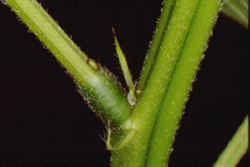
close-up of stem and leaf stalk (Photo: Marie Vitelli)

large once-compound leaves and flower cluster (Photo: Melissa Setter)

leaves with pointed leaflets (Photo: Melissa Setter)
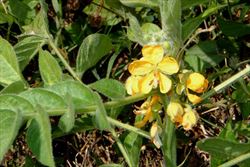
flowers (Photo: Melissa Setter)
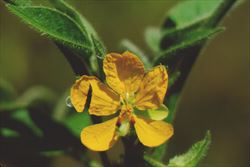
flower (Photo: Marie Vitelli)
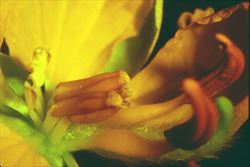
close-up of stamens (Photo: Marie Vitelli)

flowers and hairy immature fruit (Photo: Melissa Setter)
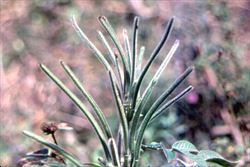
hairy immature fruit (Photo: Land Protection, QDNRW)

close-up of seeds (Photo: Tracey Slotta at USDA PLANTS Database)
Scientific Name
Senna hirsuta (L.) Irwin & Barneby
Synonyms
Cassia hirsuta L.
Family
Caesalpiniaceae (Queensland, the ACT, Victoria, Tasmania, Western Australia and the Northern Territory) Fabaceae: sub-family Caesalpinioideae (New South Wales)Leguminosae (South Australia)
Common Names
hairy senna, shower tree senna, sicklepod, slimpod glaberrima senna, stinking cassia, woolly senna, woolly wild sensitive plant
Origin
Native to southern USA (i.e. New Mexico and southern Arizona), Mexico, Central America, the Caribbean and tropical and sub-tropical South America.
Naturalised Distribution
This species has a scattered distribution in north-eastern Australia. It is mostly found in the coastal districts of northern and central Queensland, but has also been recorded in southern Queensland.
Also naturalised on several Pacific islands (i.e. the Galapagos Islands, Fiji and New Caledonia).
Habitat
A potential weed of disturbed sites, waste areas, roadsides, waterways, plantation crops, forest margins, open woodlands, pastures, grasslands and coastal environs in tropical and sub-tropical regions.
Habit
A large upright (i.e. erect) herbaceous plant, or somewhat long-lived (i.e. perennial) shrub, becoming slightly woody with age and growing 0.5-3 m tall.
Distinguishing Features
- a large upright herbaceous plant or small shrub growing 0.5-3 m tall.
- its stems, leaves and pods are all densely covered with long greyish-white hairs.
- its compound leaves have 3-6 pairs of large leaflets with pointed tips.
- there is a small finger-like projection near the base of the leaf stalk.
- its bright yellow flowers have five petals (8-15 mm long) and are borne in small clusters in the leaf forks.
- its fruit is a very slender, flattened, pod (10-18 cm long) that is usually curved slightly downwards.
Stems and Leaves
The stems, leaves and pods are all densely covered with long pale greyish-white coloured hairs. Its stems are usually also ridged lengthwise (i.e. longitudinally).
The compound (i.e. pinnate) leaves are alternately arranged along the stems and borne on ribbed stalks (i.e. petioles) 40-65 mm long. These leaves (10-25 cm long) have two to six pairs of large leaflets (40-105 mm long and 20-40 mm wide), with those further from the leaf stalk usually being noticeably larger. The leaflets are egg-shaped in outline (i.e. ovate) or oval (i.e. elliptic) in shape with pointed tips (i.e. acute or acuminate apices) and entire margins. As noted earlier, the leaf surfaces are covered in greyish-white hairs (i.e. they are densely pubescent). There is also a small cone-shaped projection (i.e. conical gland) present near the base of each leaf stalk (i.e. petiole).
Flowers and Fruit
The yellow to deep orange-yellow flowers are borne in small unbranched clusters in the upper leaf forks or at the tips of the branches (i.e. in terminal or axillary racemes). These clusters usually contain only 2-8 flowers, each flower being borne on a stalk (i.e. pedicel) 10-25 mm long. The flowers have five petals (8-16 mm long) which may become conspicuously brown-veined as they mature. They also have five sepals (6-8 mm long) and six or seven fertile stamens with anthers 3-8 mm long. Flowering occurs mainly during autumn and early winter.
The fruit is a slightly sickle-shaped (i.e. falcate) pod that is usually curved downwards (i.e. recurved). These pods (10-18 cm long and 4-6 mm wide) are very slender, slightly flattened, and densely covered in long whitish-coloured hairs (i.e. they are densely pubescent). They turn brown as they mature and are slightly indented between each of the seeds (i.e. faintly septate). The seeds are dark brown in colour, dull in appearance and rounded (i.e. globular) in shape.
Reproduction and Dispersal
This plant reproduces by seed only.
The seeds are probably dispersed by water and animals that eat the fruit. They may also be spread as a contaminant of agricultural produce or in mud sticking to animals, footwear, machinery and vehicles.
Environmental Impact
Hairy senna (Senna hirsuta) is regarded as an environmental weed in Queensland.
Legislation
This species is declared under legislation in the following states and territories:
- Queensland: Class 2 - landowners must take all reasonable steps to keep land free of this species (throughout the entire state). It is also illegal to sell a declared plant or its seed in this state.
- Western Australia: Unassessed - this species is declared in other states or territories and is prohibited until assessed via a weed risk assessment (throughout the entire state).
Management
For information on the management of this species see the following resources:
- the Biosecurity Queensland Fact Sheet on sicklepods, which is available online at http://www.dpi.qld.gov.au.
Similar Species
Hairy senna (Senna hirsuta) is very similar to sicklepod (Senna obtusifolia), Java bean (Senna tora), coffee senna (Senna occidentalis), smooth senna (Senna septemtrionalis) and the native arsenic bush (Senna planitiicola). It is also relatively similar to Easter cassia (Senna pendula var. glabrata) and pepper-leaved senna (Senna barclayana). These species can be distinguished by the following differences:
- hairy senna (Senna hirsuta) is a relatively small slender shrub (usually 0.5-2 m tall) that has leaves with several (2-6) pairs of leaflets. These relatively large leaflets (40-105 mm long) are relatively broad (20-40 mm wide) and have pointed tips (i.e. acute apices). Its flowers are borne in small clusters in the leaf forks and its very elongated (10-18 cm long) pods are usually somewhat flattened and very narrow (4-6 mm wide). These pods are slightly-curved downwards and are densely covered in long white hairs (i.e. pubescent).
- sicklepod (Senna obtusifolia) is a relatively small slender shrub (usually 0.5-2 m tall) that has leaves with a few (2-3) pairs of leaflets. The relatively large leaflets (17-65 mm long) are relatively broad (15-40 mm wide) and have rounded tips (i.e. obtuse apices). Its flowers are borne in pairs in the leaf forks and the very elongated (6-18 cm long) pods are almost rounded in cross-section (i.e. cylindrical) and very narrow (2-6 mm wide). These pods are strongly curved downwards (i.e. sickle-shaped) and are mostly hairless (i.e. glabrous).
- Java bean (Senna tora) is a relatively small slender shrub (usually 0.5-2 m tall) that has leaves with a few (2-4) pairs of leaflets. The moderately-sized leaflets (10-40 mm long) are relatively broad (10-35 mm wide) and have rounded tips (i.e. obtuse apices). Its flowers are borne in pairs in the leaf forks and its very elongated (12-25 cm long) pods are almost rounded in cross-section (i.e. cylindrical) and very narrow (2-6 mm wide). These pods are strongly curved downwards (i.e. sickle-shaped) and are mostly hairless (i.e. glabrous). This species also gives off a strong unpleasant smell.
- coffee senna (Senna occidentalis) is a relatively small slender shrub (usually 0.5-2 m tall) that has leaves with several (3-7) pairs of leaflets. The relatively large leaflets (30-100 mm long) are relatively broad (20-40 mm wide) and have pointed tips (i.e. acute apices). Its flowers are borne in small clusters in the leaf forks and its very elongated (7.5-13 cm long) pods are rounded (i.e. cylindrical) or slightly flattened and relatively thick (6-11 mm wide). These pods are straight or slightly-curved upwards and are mostly hairless (i.e. glabrous).
- smooth senna (Senna septemtrionalis) is a moderately-sized shrub (1-3 m tall) that has leaves with several (3-5) pairs of leaflets. The relatively large leaflets (45-70 mm long) are relatively broad (15-35 mm wide) and have pointed tips (i.e. acute apices). Its flowers are borne in relatively loose and somewhat elongated clusters (i.e. racemes) and its elongated (6-10.5 cm long) pods are almost rounded in cross-section (i.e. cylindrical) and relatively thick (10-15 mm wide). These pods are straight and mostly hairless (i.e. glabrous).
- arsenic bush (Senna planitiicola) is a relatively small slender shrub (usually 0.5-2 m tall) that has leaves with several (5-7) pairs of leaflets. The moderately-sized leaflets (25-50 mm long) are relatively broad (15-25 mm across) and have somewhat pointed tips (i.e. acute apices). Its flowers are borne in small clusters in the leaf forks and its relatively short (less than 8.5 cm long) pods are almost rounded in cross-section (i.e. cylindrical) and relatively thick (8-11 mm wide). These pods are straight and mostly hairless (i.e. glabrous).
- Easter cassia (Senna pendula var. glabrata) is a moderately-sized shrub (2-4 m tall) that has leaves with several (3-6) pairs of leaflets. The moderately-sized leaflets (20-50 mm long) are relatively broad (10-20 mm wide) with rounded tips (i.e. obtuse apices) and prominent yellowish coloured margins. Its flowers are borne in relatively loose leafy clusters and its elongated (10-20 cm long) pods are almost rounded in cross-section (i.e. cylindrical) and relatively thick (8-12 mm wide). These pods are relatively straight, sometimes have one or more constrictions, and are hairless (i.e. glabrous).
- pepper-leaved senna (Senna barclayana) is a low-growing shrub (usually less than 1 m tall) that has leaves with several (4-10) pairs of leaflets. The moderately-sized leaflets (20-50 mm long) are relatively narrow (4-15 mm wide) and have pointed tips (i.e. acute apices). Its flowers are borne in small clusters in the leaf forks and its relatively short (3-7 cm long) pods are almost rounded in cross-section (i.e. cylindrical) and relatively thick (6-9 mm wide). These pods are straight and hairless (i.e. glabrous).
There are many other native sennas (Senna spp.) that are also relatively similar to hairy senna (Senna hirsuta). However, these species generally have thicker pods and ten fertile stamens in each flower.

